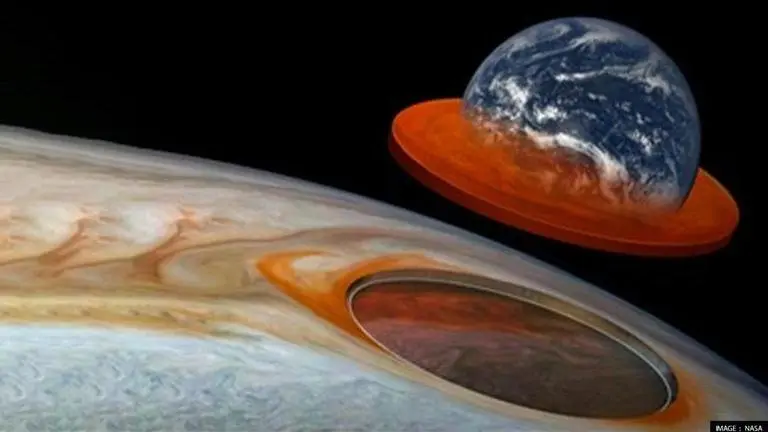Updated 29 October 2021 at 17:04 IST
Juno spills secrets: Jupiter's 500 km deep Giant Red Spot found to be wider than Earth
NASA's Juno spacecraft that was launched to Jupiter in 2011 has opened a 'treasure chest' that was presented by NASA at a live briefing on October 29.
- Science News
- 2 min read

NASA's Juno spacecraft that was launched to Jupiter in 2011 has opened a 'treasure chest' that was presented by NASA at a live briefing on October 29. This new set of data revealed by Juno has provided new insights into how Jupiter's distinctive and colorful atmospheric features offer clues about the unseen processes below its clouds. According to NASA, the new data sets carry information about the inner workings of the belts and zones of clouds encircling Jupiter, as well as its polar cyclones and even the famous Great Red Spot.
Jupiter's Great Red Spot is over 200 miles (350 km) deep, and its polar cyclones barely change location over time. New findings from our #JunoMission give a fuller picture of the planet's turbulent atmosphere: https://t.co/tZX2MsKFLl pic.twitter.com/rRO1m01gUg
— NASA (@NASA) October 28, 2021
The Giant Red Spot is about 500 kilometres deep
If there's something Jupiter is famous for, it is the Giant Red Spot which is an iconic anticyclone that has been active since the last two centuries. Anticyclones work exactly opposite of a cyclone as the former are colder at the top and warmer at the bottom while the latter is warmer at the top and colder at the bottom. Juno's observations revealed that the depth of the Great Red Spot is about 500 kilometers below the dense dust clouds.
Juno was able to peer through Jupiter’s cloud tops and probe the structure of its numerous vortex storms with the help of its microwave radiometer (MWR). Interestingly, the red spot is massive enough to swallow Earth as a whole. According to NASA, Scott Bolton, principal investigator of Juno and lead author of the study on the depth of Jupiter’s vortices said-
"Previously, Juno surprised us with hints that phenomena in Jupiter’s atmosphere went deeper than expected. Now, we’re starting to put all these individual pieces together and getting our first real understanding of how Jupiter’s beautiful and violent atmosphere works – in 3D."
In addition to the giant storm, Juno also provided details about Jupiter's distinctive belts and zones – white and reddish bands of clouds that wrap around the planet. Juno revealed that strong east-west winds moving in opposite directions separate the bands and these winds, or jet streams, reach depths of about 3,200 kilometers.
Advertisement
Launched in August 2011, the Juno spacecraft has been sending data about Jupiter since it entered its orbit in 2016. The spacecraft is now active as part of an extended mission that involves close passes of Jupiter’s north polar cyclones, future flybys of the moons Europa and Io, and the first exploration of the faint rings encircling the planet, as per NASA.
Image: NASA
Published By : Harsh Vardhan
Published On: 29 October 2021 at 17:04 IST


